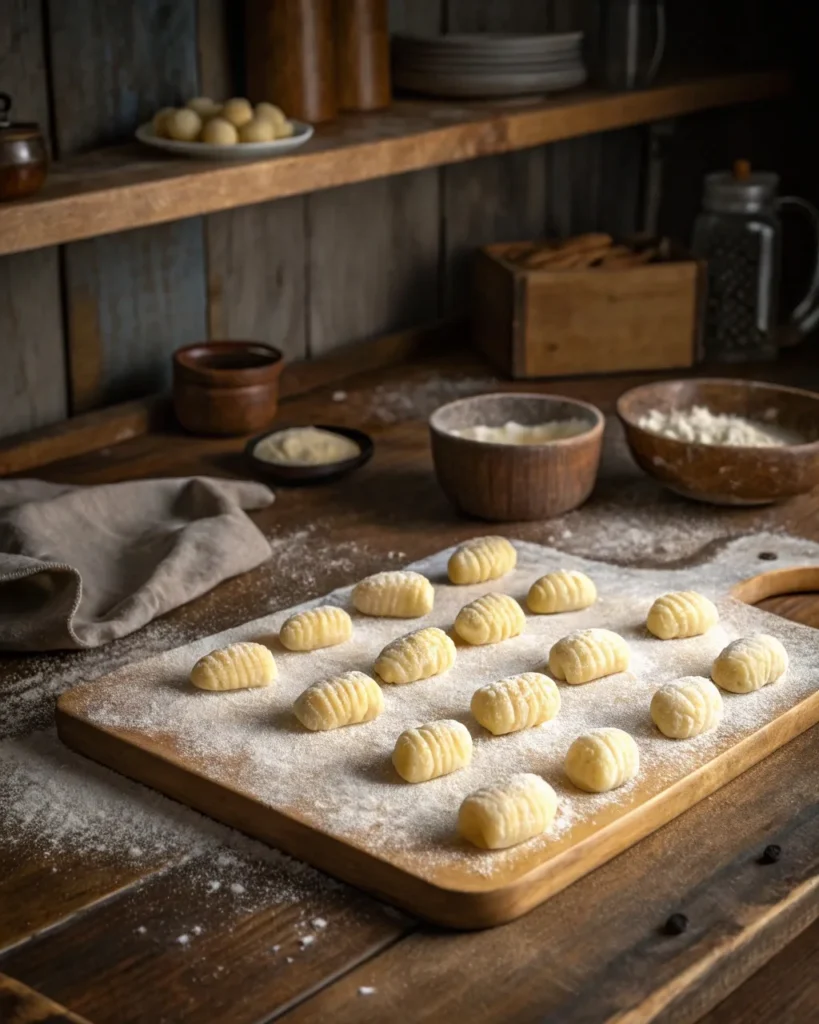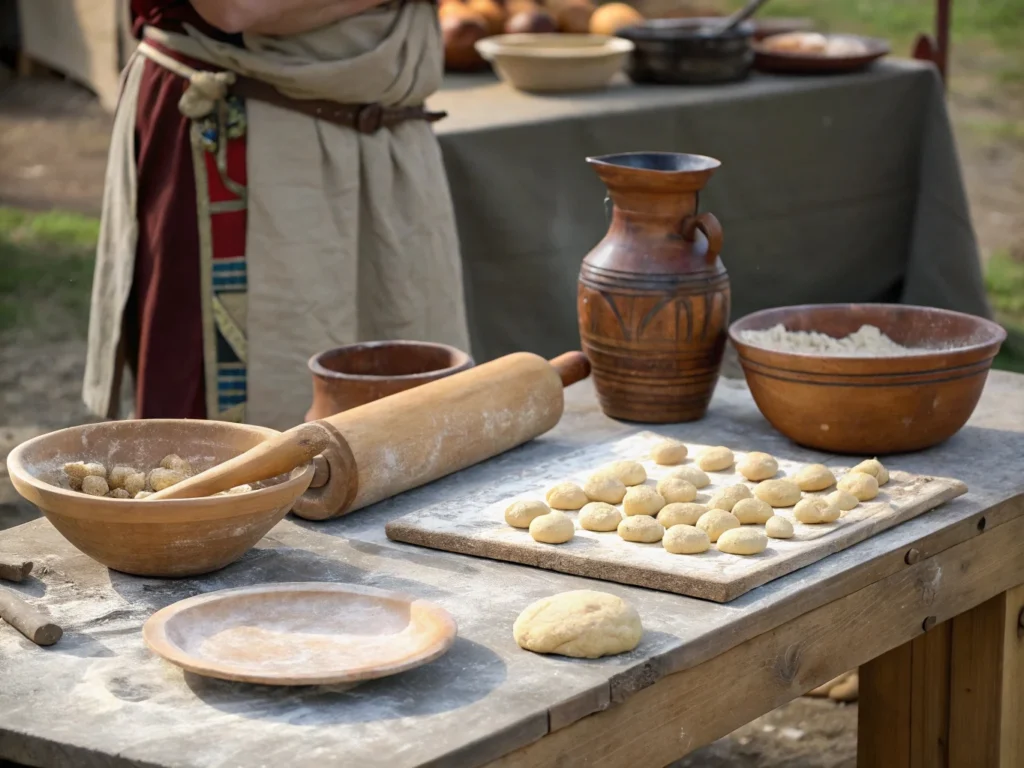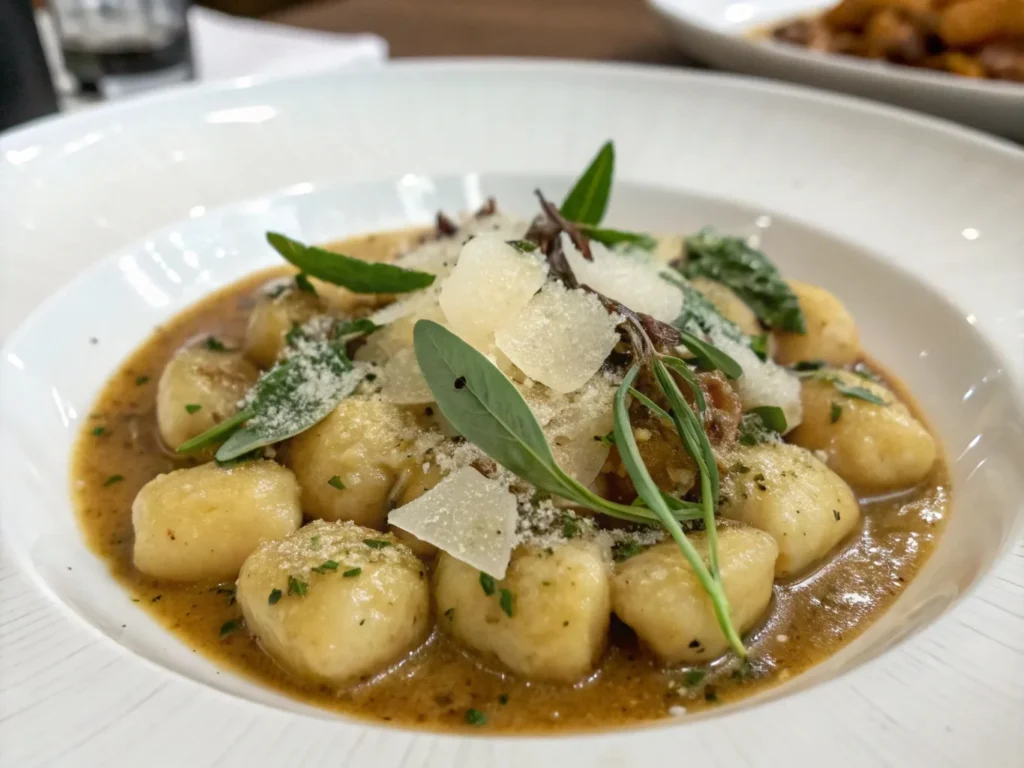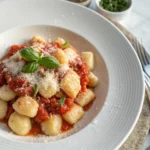What does gnocchi mean in English? Far more than a simple translation, the answer reaches back to ancient Italian words for “knot” and “knuckle.”
It’s full of treasures like gnocchi, loved by food fans everywhere. The word gnocchi means more than just a dish. It’s a journey into Italian culture, starting with its roots.
Gnocchi comes from the Italian words for ‘knot in wood’ or ‘knuckle’. These small dumplings are more than a meal. They are a part of Italy’s cooking tradition, passed down for ages.
As we look into gnocchi, we find a story of tasty little treats. They are a key part of Italian food, loved by many.

What Does Gnocchi Mean in English? More Than Just a Translation
Exploring food translation uncovers interesting stories. Gnocchi is a great example of how language and food are connected. It’s more than just a dish on a menu.
The definition of gnocchi is more than just a dumpling. It has a deep historical meaning. Experts say the word comes from two possible origins:
- From nocchio: meaning ‘a knot in wood’
- From nocca: referring to ‘knuckle’
These roots show the dumpling’s shape and its cultural background. Menu translators often point out the deep cultural meanings in food terms.
Unraveling Linguistic Mysteries
Food translation shows that gnocchi’s name might describe its shape. The word makes you think of small, knotted shapes. These resemble wooden knots or knuckles, showing Italian creativity in language and food.
Italians have a unique way of turning simple words into culinary art. Seeing gnocchi on a menu is like peeking into a piece of history. It’s a mix of language and food.
- Shape inspired by wood knots
- Reflects traditional cooking techniques
- Represents cultural storytelling through food
Next time you eat gnocchi, think about the journey of its name. Each bite connects you to Italy’s rich culinary and language history.
The Evolution of Gnocchi: From Ancient Rome to Modern Kitchens
Gnocchi, a favorite in Italy, has a long history. These tasty potato dumplings have changed a lot over the years. They’ve been shaped by cooking and cultural exchange.
The story of gnocchi starts in Ancient Rome. Recipes from the 1st century CE show its early beginnings. Roman soldiers helped spread this dish across Europe. Back then, gnocchi were not made with potatoes.

A Culinary Time Travel
Gnocchi’s history is full of interesting changes:
- 14th century: Bread-based gnocchi became part of “cucina povera” (peasant cuisine)
- 16th century: Potatoes from South America changed the recipe
- 1531: Verona started Gnocchi Friday during a famine
The 16th century was a big moment for gnocchi. Chefs started using potatoes, making them soft and fluffy. This is how we know gnocchi today.
Over time, different regions made their own gnocchi. In Rome, they use semolina. In Piedmont, they use pumpkin. Each place has its own special way of making gnocchi.
Gnocchi Across Italy: Regional Variations and Specialties
Italian cuisine is a mix of flavors from different regions. Gnocchi show this diversity well. Each region adds its own twist to this tasty pasta.
Potato gnocchi are very popular in many places. They are loved in:
- Lombardy
- Abruzzo
- Friuli-Venezia Giulia
- Veneto
- Lazio
A Journey Through Regional Gnocchi Styles
Gnocchi vary a lot across Italy. Gnocchi di pane is made from breadcrumbs in Friuli-Venezia Giulia, Veneto, and Trentino-Alto Adige. In Rome, gnocchi alla romana uses semolina instead of potatoes.
| Region | Gnocchi Variation | Key Ingredients |
|---|---|---|
| Piedmont | Pumpkin Gnocchi | Pumpkin, flour |
| Tuscany | Ricotta Gnocchi | Ricotta cheese, flour |
| Sorrento | Classic Potato Gnocchi | Potatoes, tomato sauce, mozzarella |

Every region makes gnocchi in its own special way. They use local ingredients and follow old traditions. From light gnudi in Tuscany to hearty ones with herbs and meats, gnocchi share Italy’s rich story.
The Art of Making Gnocchi: Ingredients and Techniques
Making authentic italian potato dumplings needs skill, passion, and detail. Gnocchi pronunciation might seem hard, but learning the technique is simpler than you think!
Let’s explore the key ingredients and techniques for making great gnocchi. The secret to perfect gnocchi is choosing the right potatoes and balancing ingredients well.
Essential Ingredients for Perfect Gnocchi Dough
The foundation of great gnocchi is the right ingredients. Here’s what you’ll need:
- 1 pound Yukon Gold or Russet potatoes
- 1 cup all-purpose flour
- 1 medium egg
- ½ teaspoon salt
Older potatoes are best for gnocchi because they have less water. This makes the dough more consistent. The right potato is key to your italian potato dumplings!
| Ingredient | Purpose | Quantity |
|---|---|---|
| Potatoes | Base of the dough | 1 pound |
| Flour | Binding agent | 1 cup |
| Egg | Additional binding | 1 medium |
| Salt | Flavor enhancement | ½ teaspoon |
Pro tip: Let your gnocchi dough rest for about 20 minutes before shaping. This lets the ingredients blend, making the dough more cohesive.
When cooking, remember that perfect gnocchi cooks in 1-2 minutes in boiling salted water. They’re done when they float to the top. This is a magical moment for any home cook!
For a practical guide, try this authentic Gnocchi di Patate recipe that walks you through every step from potato to plate.
Beyond Potato: Exploring Gnocchi Variations
Gnocchi has a rich history that goes beyond the classic potato version. Traditional Italian dishes show amazing creativity in making these dumplings. While potato gnocchi is loved, there are many other recipes that will amaze you.
Let’s look at some exciting gnocchi variations that go beyond the traditional potato base:
- Ricotta Gnocchi: Light and delicate, made with fresh ricotta cheese and flour
- Semolina Gnocchi: A Roman-style version using semolina flour
- Spinach Gnocchi: Vibrant green dumplings incorporating fresh spinach
- Pumpkin Gnocchi: Soft, sweet dumplings with a beautiful orange hue
Each variation has its own texture and flavor. The Sicilian street food tradition inspires with unique combinations like the crocchè. It blends mashed potatoes, eggs, and multiple cheese types.
Crafting Unique Gnocchi Recipes
Try different ingredients to make your own gnocchi. Add herbs like basil or rosemary, or mix in roasted vegetables and specialty cheeses. The key is mastering the basic technique and then letting your creativity run wild.
Pro tip: When trying new gnocchi recipes, find the right balance between moisture and flour. Soft, pillowy dumplings are the ultimate goal!
Gnocchi Around the World: Global Adaptations and Influences
Gnocchi has become a dish loved around the world. Italian immigrants took their favorite recipes with them, introducing gnocchi to many places. This shows how Italian food has spread far and wide.
The story of gnocchi is full of interesting changes. In South America, like Argentina, Paraguay, and Uruguay, gnocchi is a favorite. It shows how Italian food has reached beyond Italy’s borders.
International Gnocchi Traditions
Every place has made gnocchi their own:
- Argentina has a special day for gnocchi, called “Dia de Ñoquis,” on the 29th.
- In Brazil, they make gnocchi with cassava, a local ingredient.
- French chefs add their own touch with special cheeses.
Gnocchi’s journey shows how Italian food can change and grow. Each place adds its own twist, making gnocchi a dish loved everywhere.
| Country | Gnocchi Variation | Unique Ingredient |
|---|---|---|
| Argentina | Ñoquis | Served with monetary blessing |
| Brazil | Nhoque | Cassava flour |
| France | Gnocchis | Regional cheese blend |
Gnocchi shows how food can bring people together. It has traveled from Italy to the world, inspiring new recipes and flavors.
Serving Suggestions: Perfect Pairings for Gnocchi
Exploring traditional Italian dishes means learning how to serve gnocchi. These potato dumplings are very versatile. They are a highlight in the italian cuisine glossary.
Here are some classic ways to serve gnocchi:
- Simple butter and sage sauce
- Rich tomato-based pomodoro sauce
- Creamy four-cheese blend
- Pesto with fresh basil
Crafting the Perfect Gnocchi Plate
Pair your gnocchi with ingredients that match its texture. The right sauce can turn these dumplings into a top-notch dish.
| Sauce Type | Recommended Pairing | Preparation Time |
|---|---|---|
| Pomodoro Sauce | Fresh mozzarella, basil | 30-40 minutes |
| Brown Butter Sage | Parmesan cheese, pine nuts | 15-20 minutes |
| Gorgonzola Cream | Walnuts, fresh thyme | 25-30 minutes |

Gnocchi cook fast, usually when they float. This makes them great for quick weeknight meals or special events.
Looking for a hearty twist? This Tuscan chicken meatballs and gnocchi recipe makes a rich and comforting one-pot meal.
Gnocchi in Modern Cuisine: Contemporary Twists and Innovations
The world of cooking is always changing, and gnocchi is at the heart of these changes. Chefs are making this old dish new again with creative methods and flavors.
Modern cooking sees gnocchi as a blank slate for new ideas. Chefs in fancy restaurants and home cooks alike are exploring new ways to make this traditional dumpling.
Innovative Gnocchi Techniques
Today’s chefs are trying out new ways to make gnocchi:
- Molecular gastronomy-inspired gnocchi spheres
- Gluten-free versions using different flours
- Vegan gnocchi made from plants
- Fusion flavors mixing different cooking styles
It’s important to explain these new dishes well. Restaurants now write detailed descriptions to show off their modern gnocchi creations.
| Culinary Approach | Innovative Technique | Flavor Profile |
|---|---|---|
| Molecular Gastronomy | Spherified Gnocchi | Intense Concentrated Flavor |
| Fusion Cuisine | Asian-Inspired Gnocchi | Complex Umami Notes |
| Plant-Based Cooking | Vegetable-Based Gnocchi | Lighter, Nutritious Texture |
Chefs like Liz Johnson are at the forefront, making unexpected combinations like gnocchi with uni and white asparagus. These new ideas show how gnocchi can be reinvented for today’s tastes.
The Nutritional Profile of Gnocchi: Health Benefits and Considerations
Exploring italian potato dumplings reveals more than just tasty food. Gnocchi has a surprising nutritional profile that health enthusiasts will find interesting. Knowing what’s in gnocchi helps you make better food choices while enjoying this Italian favorite.
The traditional gnocchi has a rich nutritional profile. Let’s look at the main nutritional points:
- Carbohydrate content: Mostly from potatoes and flour
- Protein sources: Eggs and sometimes cheese
- Moderate calorie count: About 150-200 calories per serving
When making gnocchi at home, you can make it healthier. Try using whole wheat flour or adding veggies to increase nutrition. The potatoes in gnocchi give you important nutrients like:
- Vitamin C
- Potassium
- Dietary fiber
- Complex carbohydrates
For detailed nutrition breakdowns by type, check out this Gnocchi Calorie Guide.
Balancing Nutrition and Enjoyment
Controlling portion sizes is important for a balanced diet with gnocchi. A good serving size is 150-200 grams. This lets you enjoy gnocchi without losing sight of your health goals. Pairing it with lean proteins and veggies makes it a nutritious meal.
Gnocchi isn’t usually seen as a diet food. But, it can be part of a healthy diet if eaten wisely. The trick is to know what’s in it and choose how to prepare and serve it.
Gnocchi in Popular Culture: From Literature to Cinema
Italian cuisine has long inspired artists, writers, and filmmakers. Gnocchi, a key part of Italian food, has become a beloved character in many stories. It goes beyond being just a traditional dish.
In books, gnocchi mean more than just food. Italian novels often use food to tell stories. They show how gnocchi connect to family, memories, and culture. Writers like Elena Ferrante use food to add depth to their stories, showing its emotional value.
Gnocchi on the Silver Screen
Movies love gnocchi just as much as books do. Italian films show how to make these tasty dumplings, making cooking a special part of the movie. Documentaries about Italian food often highlight gnocchi as a symbol of culinary heritage.
- Food documentaries exploring regional Italian cooking
- Culinary-themed movies celebrating traditional preparation methods
- Nostalgic narratives connecting food with family memories
Gnocchi has also appeared in other media. Social media and food blogs often share recipes and stories about making gnocchi. This introduces this traditional dish to people all over the world.
The story of gnocchi shows the richness of Italian food traditions. It moves from local kitchens to global screens. These small dumplings carry stories of passion, creativity, and pride in culture.
Gnocchi Festivals and Traditions: Celebrating the Beloved Dumpling
Dive into the vibrant world of traditional Italian dishes that bring communities together through delicious celebrations. Gnocchi stands out as a culinary treasure in the italian cuisine glossary, with festivals that transform this simple dumpling into a cultural phenomenon.
In South America, a unique tradition captures the essence of gnocchi’s cultural significance. Countries like Uruguay, Paraguay, and Argentina have embraced a charming custom of eating gnocchi on the 29th of each month. This ritual goes beyond mere dining – it’s a practice believed to bring prosperity and good luck.
Festive Celebrations of Gnocchi
Verona, Italy, takes gnocchi celebrations to another level with its spectacular Venerdì Gnocolar (Gnocchi Friday). This festive event during Carnevale features:
- A vibrant parade led by Papà del Gnoco (Father of Gnocchi)
- Costumes representing the colors of gnocchi and meat sauce
- Community-wide celebrations of this beloved traditional dish
The cultural significance of gnocchi extends far beyond its culinary roots. These festivals showcase how a simple dumpling can unite people, preserve traditions, and create lasting memories. From small village gatherings to elaborate city celebrations, gnocchi continues to be a symbol of Italian culinary heritage.
Whether you’re a food enthusiast or a curious traveler, exploring gnocchi festivals offers a delightful glimpse into the heart of Italian food culture. Each celebration tells a story of community, tradition, and the joy of sharing a delicious meal.
Mastering Gnocchi: Tips and Tricks for Home Cooks
Making perfect italian potato dumplings takes patience and practice. Learning how to say gnocchi is just the start. The real challenge is finding the right mix of ingredients and technique to make them soft and delicious.
When you roll out the dough, make sure all your gnocchi are the same size and shape. Use a fork to make those ridges that help sauce stick to them. Chefs say to handle the dough gently to avoid making it tough.
Having the right tools can help a lot when making gnocchi. While you don’t need special equipment, a potato ricer makes the dough smoother. For better results, practice your skills and choose the right potatoes.
Getting good at making gnocchi takes time. Don’t worry if they’re not perfect at first. Each try helps you get better, teaching you how to work with the dough. Try different potatoes and use fresh ingredients for the best taste.
So next time someone asks you what does gnocchi mean in English, you’ll have the history, culture, and flavor-packed answer.
FAQ
1. What does gnocchi mean in slang?
In Italian slang, “gnocca” (feminine form related to gnocchi) can refer to an attractive woman, though it’s casual and sometimes cheeky. While “gnocchi” as a food means dumplings, the slang version highlights how Italian words often evolve playful meanings in everyday speech.
2. What are the 3 types of gnocchi?
The three most recognized types of gnocchi are:
- Potato Gnocchi – the classic version made with potatoes, flour, and eggs.
- Ricotta Gnocchi – softer and lighter, made with ricotta cheese.
- Semolina Gnocchi – also known as gnocchi alla romana, made with semolina flour and baked in slices.
3. How do the Italians say gnocchi?
Italians pronounce gnocchi as “NYO-kee”. The “gn” is like the “ñ” in Spanish, and the “c” is silent. It’s a soft, nasal sound at the start that often confuses English speakers.
Want to sound like a native? Here’s a quick pronunciation guide to help you master it the Italian way.
4. Is gnocchi Italian or Japanese?
Gnocchi is 100% Italian. While Japanese cuisine features dishes like mochi that may appear visually similar, gnocchi originated in Italy, tracing back to Ancient Roman times and evolving across various regions of the country.
5. Why do Italians eat gnocchi on the 29th?
In countries like Argentina (influenced by Italian immigrants), eating gnocchi on the 29th of each month is a tradition believed to bring prosperity. It’s often paired with placing coins under the plate to attract good fortune.

Authentic Italian Potato Gnocchi
- Total Time: 40 minutes
- Yield: 4 servings 1x
Description
Soft, pillowy, and packed with tradition, these authentic Italian potato gnocchi are a timeless favorite. Whether you’re new to gnocchi or a seasoned cook, this recipe will guide you through creating perfect dumplings right at home—with tips, tricks, and serving ideas straight from the heart of Italy.
Ingredients
1 pound Yukon Gold or Russet potatoes
1 cup all-purpose flour (plus more for dusting)
1 medium egg
½ teaspoon salt
Instructions
1. Boil the potatoes with skins on until tender. Let cool slightly, then peel.
2. Pass the potatoes through a potato ricer or mash very finely.
3. Mix the potatoes with flour, egg, and salt until a soft dough forms. Do not overwork.
4. Let the dough rest for 20 minutes.
5. Roll the dough into ropes, then cut into ¾-inch pieces.
6. Gently roll each piece against a fork or gnocchi board to create ridges.
7. Bring a large pot of salted water to a boil.
8. Cook gnocchi in batches. When they float to the surface (about 1-2 minutes), they’re done.
9. Drain and toss immediately with your sauce of choice.
Notes
Use older, starchy potatoes like Russets for best texture.
Let the dough rest before shaping for smoother gnocchi.
Freeze extra gnocchi raw: spread on a tray, freeze, then transfer to a bag.
- Prep Time: 30 minutes
- Cook Time: 10 minutes
